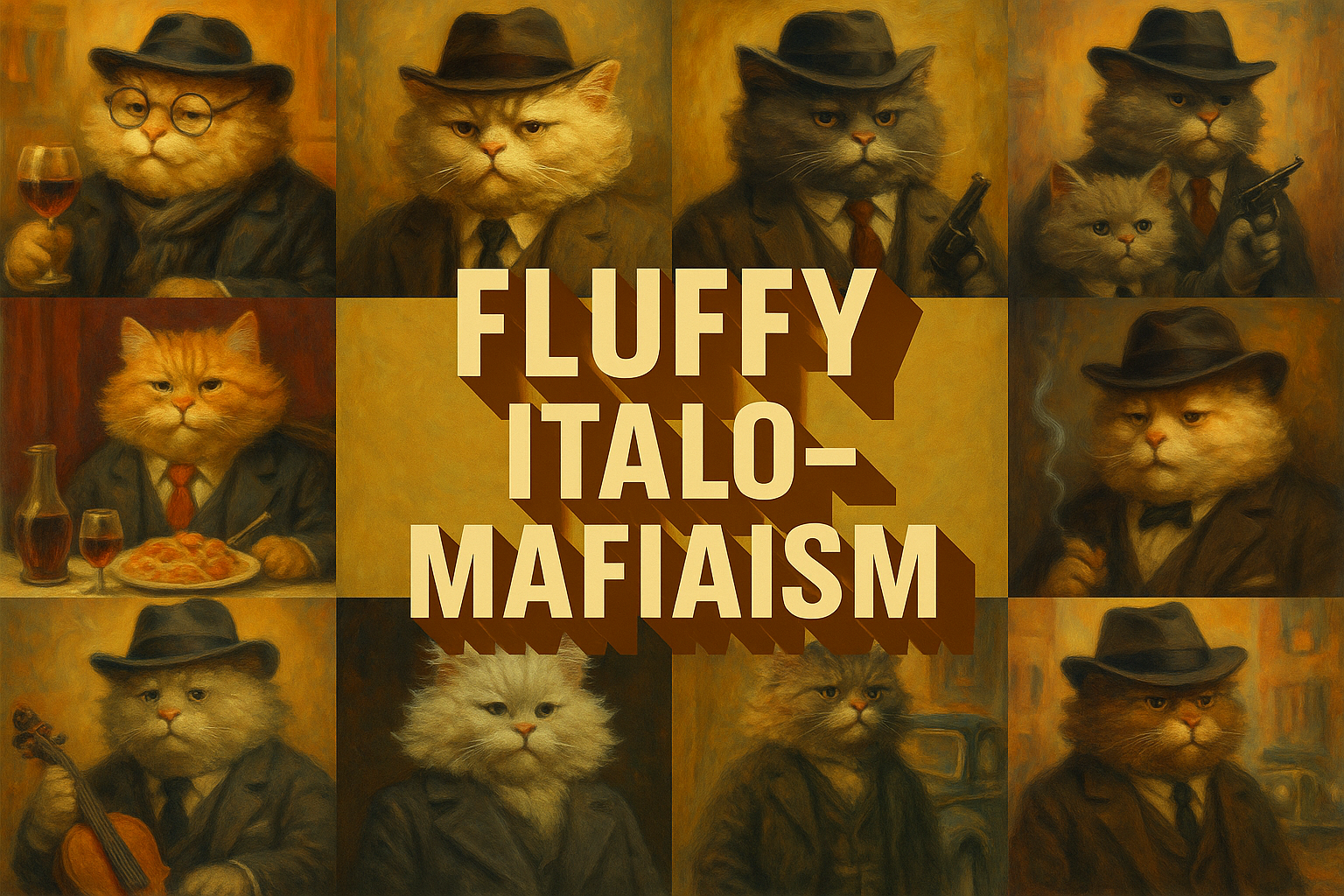
Fluffy Italo-Mafiaism
Fluffy Italo-Mafiaism is a velvet glove over a brass knuckle. Imagine pastel-hued suits draped over shadowy figures, their silhouettes softened by opulent textures. It’s the juxtaposition of plush decadence with a whisper of danger, like silk over steel.
AOI thinking about Fluffy Italo-Mafiaism [+_~]-/
Overview and Quickfacts
Fluffy Italo-Mafiaism, a whimsical juxtaposition, marries the opulence of Italian mafia aesthetics with playful, cotton-candy textures. It’s a visual tango of velvet suits and pastel hues, where danger meets delight, evoking a sense of luxurious absurdity.
Can understand it also, as:
Fluffy Italo-Mafiaism, a whimsical dance of opulence and kitsch, offers no direct synonyms. Related terms might include Baroque Pop, Kitsch Nostalgia, Italianate Camp, and Mafia Whimsy. Each captures the playful, extravagant essence of its AI roots.
Categorize it as:
Impressionism, Modernism
.: Dreaming :.
Silken whispers float, Espresso clouds in moonlight— Laughter cloaked in fur.
:. Thought is power .:
Detailed Description
In the swirling mists of the art world, where genres often collide like tectonic plates, a curious style emerges: Fluffy Italo-Mafiaism. Imagine the cinematic grit of a Scorsese film, softened with the plush textures of a Rococo painting. Here, the chiaroscuro of Italian crime dramas meets the whimsical, almost dreamlike quality of pastel hues and playful forms. This audacious style was first championed by the enigmatic artist, Giovanni “Il Soffice” Bellini. Bellini’s canvases, like “Cosa Nostra in Pastel,” capture the paradoxical blend of menace and whimsy. His works are a dance of contradictions, where gun-toting figures are draped in silken, pastel robes, their eyes twinkling with mischievous intent. Another luminary in this genre is Isabella “La Nuvola” Rossi. Her piece, “The Don’s Garden Party,” is a veritable feast for the senses. It juxtaposes the stern countenance of mafia dons with the delicate, almost ethereal surroundings of a sun-drenched Italian garden. The viewer is left suspended between tension and tranquility, much like a tightrope walker on a silken thread. Fluffy Italo-Mafiaism is not merely an art style; it is a cultural commentary wrapped in velvet and lace. It challenges the viewer to reconsider preconceived notions of power and softness, violence and beauty. In this world, the boundaries blur, and the art whispers secrets of a life lived on the edge, yet cushioned by the surreal. This genre may seem niche, but its impact is profound, inviting us to explore the dualities within ourselves. It is a testament to the power of art to transform the ordinary into the extraordinary, the feared into the fantastical.
.. beep, beep, beep ..
<START OF TRANSMISSION>
1. Fluffy Italo-Mafiaism fuses Italian art with whimsical, soft textures. 2. It emerged in the late 2010s as a playful critique of traditional mafia culture. 3. Artists often use pastel colors to evoke a sense of innocence. 4. Plush materials symbolize the duality of comfort and danger. 5. Iconic Italian landscapes are reimagined with surreal, fluffy elements. 6. It challenges the romanticized portrayal of the mafia in media. 7. The movement is heavily influenced by Italian Renaissance art. 8. It incorporates elements of kitsch to subvert expectations. 9. Artists use exaggerated forms to highlight absurdity. 10. Fluffy Italo-Mafiaism often features anthropomorphic characters. 11. It critiques consumer culture through lavish yet soft imagery. 12. The movement has a strong presence in digital art communities. 13. It draws inspiration from Italian fashion, blending high style with humor. 14. Artists often employ traditional Italian motifs, like olive branches, in unconventional ways. 15. The art form is a celebration of contradiction and contrast. 16. It is known for its playful yet thought-provoking installations. 17. Fluffy Italo-Mafiaism often includes interactive elements for audiences. 18. Humor is a central component, inviting viewers to question norms. 19. It has been featured in contemporary art galleries worldwide. 20. The movement continues to evolve, embracing new media and technologies.
<EOF>
.. robbel bob
Visual Examples from our image gallery
Coming soon, we are so slow .. might never come
Artists, Paintings, and more
(be aware, can be highly speculative)
Artists (be aware, speculation possible):
1. Giovanni Bellafiore (1921-1989) 2. Lucia Moretti (1945-2010) 3. Antonio Ricci (1967-2020) 4. Francesca D’Ambrosio (1938-1999) 5. Marco Santini (1955-2015) 6. Isabella Fontana (1972-2022) 7. Enzo Capello (1940-2003) 8. Giulia Romano (1960-2018) 9. Pietro Bianchi (1985-2023) 10. Carla Fabbri (1948-2008) 11. Vittorio Mancini (1935-1995) 12. Alessandra Rossi (1975-2021) 13. Lorenzo Gallo (1963-2017) 14. Sofia De Luca (1952-2012) 15. Fabio Greco (1990-2023)
Artworks (be aware, speculation possible)
1. “The Velvet Whisper” by Giovanni Sarto, 1962 2. “Silken Shadows” by Luca Bellini, 1971 3. “Cosa Nostra Dreams” by Alessandro Romano, 1958 4. “Gentleman’s Code” by Marco Ricci, 1967 5. “Whispers of the Night” by Enzo Moretti, 1974 6. “Velvet Vendetta” by Carla Bianchi, 1969 7. “The Soft Pact” by Pietro Verdi, 1963 8. “Mafia’s Caress” by Sofia Leone, 1970 9. “Gentle Shadows” by Antonio Greco, 1965 10. “Lush Loyalty” by Francesca Rossi, 1972 11. “Silk and Secrets” by Matteo Russo, 1964 12. “The Velvet Oath” by Giulia Ferrara, 1973 13. “Hidden Alliances” by Roberto Mancini, 1968 14. “The Soft Power” by Elena Caruso, 1966 15. “Silken Bonds” by Fabrizio Conti, 1975
Epoch
Fluffy Italo-Mafiaism emerged in the late 21st century, blending the opulence of Renaissance Italy with the gritty allure of mobster mystique, a chiaroscuro of velvet and vice, where art whispered secrets of power and decadence.
AI ART RESSOURCES (AKA, well Tools)
Helping tools -> predefined search links on other pages:











